Java Tech Popularity Index Q1/2024: Back-End Frameworks
Summary for Q1/2024
Here is the scorecard of Spring Boot (left) and Quarkus (right) vs. Jakarta EE (100%), not on the card. The arrows show the trend vs. Jakarta EE.

Spring Boot pulls away from Jakarta EE everywhere except for job ad mentions. Quarkus gains on Jakarta EE everywhere.
Here are my recommendations:
- On your current project, keep your existing back-end framework unless that framework is absolutely, really not working out for you.
- If you need to switch back-end frameworks or are on a new project:
- Use Quarkus if you need the smallest possible, fastest-starting Java application now.
- Otherwise, use Spring Boot.
Archive
| 2023 | Q4 | Q3 | Q2 | Q1 | ||||
| 2022 | Q4 | Q3 | Jun | May | Apr | Mar | Feb | Jan |
| 2021 | Dec | Nov |
Table Of Contents
Choices
Here are the choices in alphabetical order:
- Dropwizard
- Oracle’s Helidon
- Eclipse Jakarta EE (was Java EE before)
- Micronaut
- Eclipse MicroProfile
- VMWare’s Spring Boot
- Red Hat’s Quarkus
Popularity
Why Popularity - and How?
Picking a popular technology makes our developer life easier: Easier to learn, easier to build, debug & deploy, easier to find jobs/hire, and easier to convince teammates & bosses. Popularity can make a difference in two situations: When multiple technologies score similarly, we could go for the most popular one. And when a technology is very unpopular, we may not use it.
I measure popularity among employers and developers as the trend between competing technologies. I count mentions in job ads at Indeed for employer popularity. For developer popularity, I use Google searches, Udemy course buyers, and Stack Overflow questions.
Employers: Job Ads
The Indeed job search is active in 62 countries. I picked 59 countries representing 69% of the worldwide GDP in 2022, excluding three countries because English word searches proved ineffective there: China, Japan, and South Korea. Job searches demonstrate the willingness of organizations to pay for a technology - the strongest indicator of popularity in my mind. Jakarta EE is the baseline. The chart is not proportional, so all frameworks fit nicely.

There are no job numbers for May and December 2023 because of changes on the Indeed websites.
Spring Boot wins, Jakarta EE is second, Quarkus third, and Micronaut fourth. After some ups and downs last year, Spring Boot is back to five times Jakarta EE’s numbers it had at the end of 2022. Quarkus at number three just hit its all-time high, whereas Micronaut at number four sunk to a third of Quarkus’ numbers. Dropwizard is a steady number five at 4% of Jakarta EE. Helidon and MicroProfile are last at 2% and 1% respectively.
Comparing November 2023 vs. November 2022, job ads are down 32%.
Please see here for details, caveats, and adjustments to the job ad mentions.
You can find the detailed search results with links here. They include breakdowns by continents:
Developers
Courses Bought at Udemy
Udemy is one of the biggest online learning sites. They publish the number of people who bought a course (beyond a certain threshold, possibly around 100k). This shows how many people evaluate a technology. Jakarta EE is the baseline. The other frameworks haven’t crossed the reporting threshold for Udemy (probably around 100,000 students).
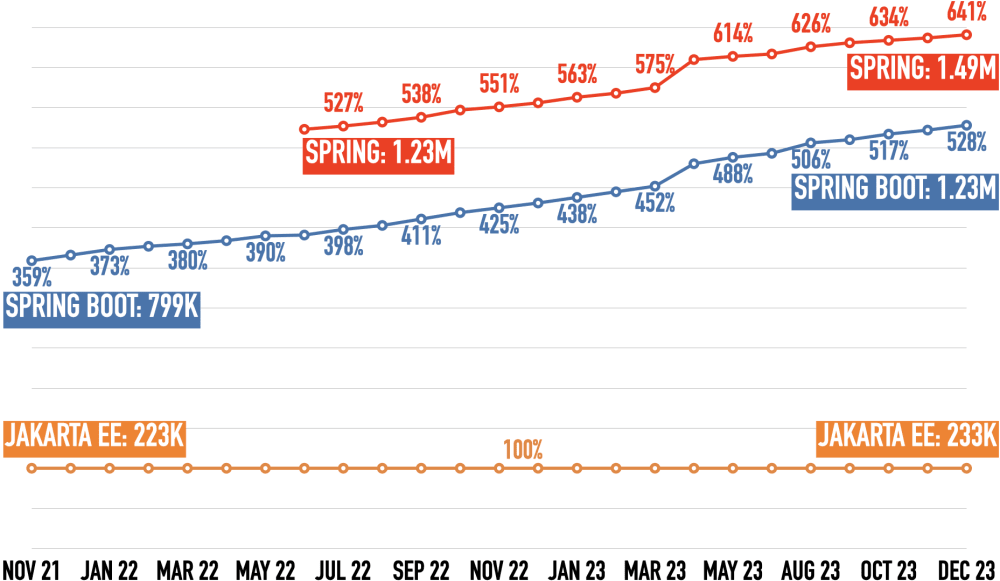
Spring Boot wins over Jakarta EE and increases its lead from 3.6:1 to 5.3:1 over the last two years. The Spring Framework also grows strongly but loses to Spring Boot. In April 2023,Udemy decreased the number of Jakarta EE students from 242k to 230k – a slight share increase for Spring and Spring Boot.
Here are the links that show the courses for all and the number of students for some:
Google Searches
Google Trends demonstrates the initial interest in a technology over time. “More searches = better” to me. The percentage behind the current value is the drop-off from the peak value, marked with a circle. Here are all the frameworks, but Helidon - Google Trends only allows five at the same time:
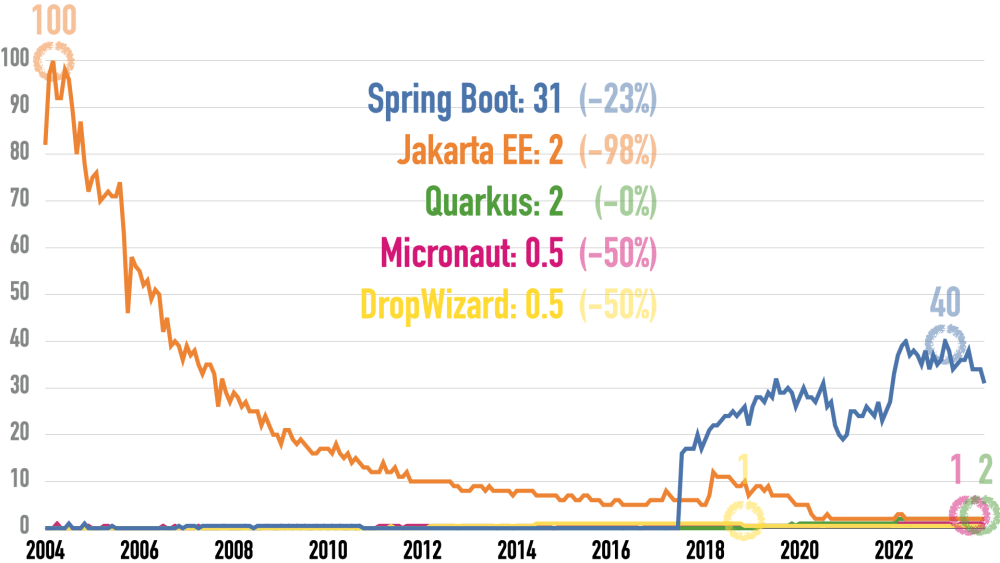
Google changed its measurement algorithms on January 1, 2016, and January 1, 2022. That caused spikes for all values, especially in 2022.
This link produces the chart above. This version switches in Helidon for Micronaut and this one MicroProfile, which doesn’t make a difference in the chart.
Spring Boot wins, Jakarta EE is second, Quarkus third, Micronaut fourth, and DropWizard fifth. Google searches always decline in December. Jakarta EE lost 98% since 2004, equaling Quarkus at two today. Spring Boot has been declining and is 25% off its all-time high. It leads Quarkus and Jakarta EE 15:1. Quarkus just hit its peak value. Micronaut and DropWizard are below 1.
Let’s zoom in on the five challengers over the last three years (chart link):
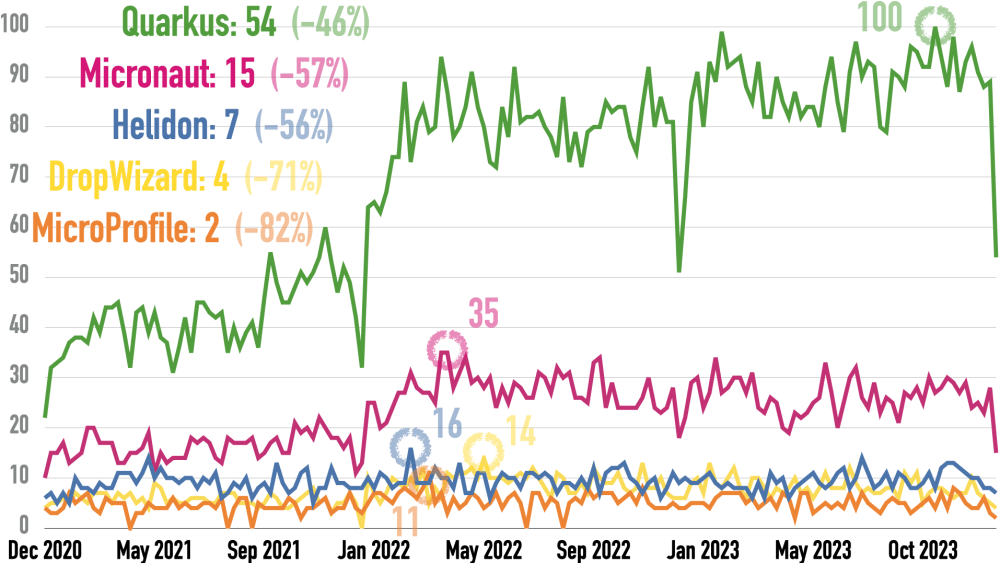
Quarkus leads the new frameworks. Quarkus has more than doubled in the last three years and just hit its usual year-end dip. Micronaut and Helidon hit their all-time highs in early 2022. Micronaut has declined since then but still has twice the searches of Micronaut which held steady.
How does Jakarta EE fare against Quarkus over the last three years (chart link)?
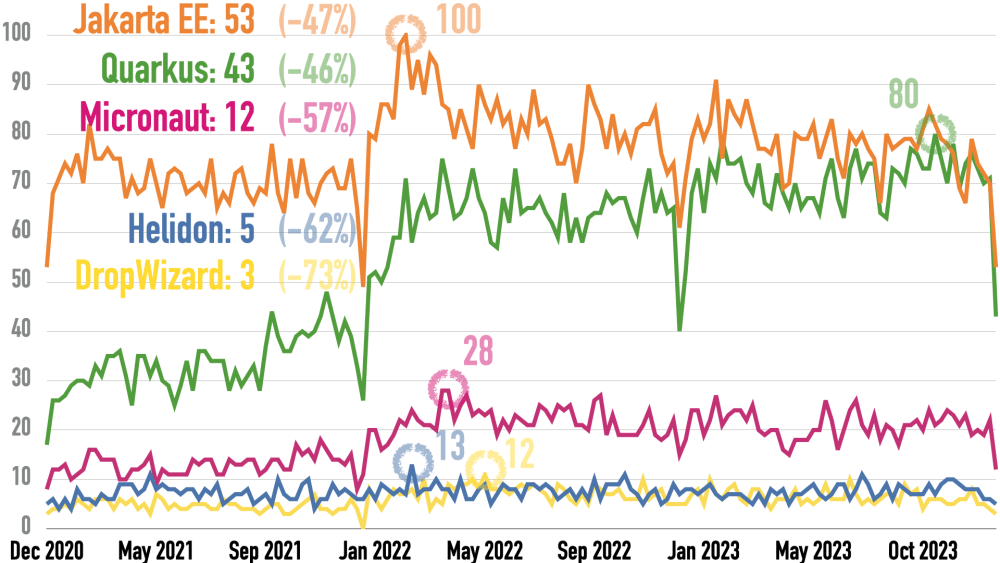
Jakarta EE beats Quarkus narrowly. Jakarta EE has the same strong year-end dips as Quarkus, leading by 19%. But while Jakarta EE has declined in the last two years, Quarkus has risen.
Monthly Questions at Stack Overflow
We can run database queries against the questions, answers, and comments at Stack Overflow with the StackExchange Data Explorer. The number of monthly questions is a proxy for using a technology during evaluation and productive use. This number includes deleted questions to be more accurate, as Stack Overflow automatically deletes questions without answers after a year. This number includes deleted questions to be more accurate, as Stack Overflow automatically deletes questions without answers after a year. “More questions = better” to me. The percentage behind the current value is the drop-off from the peak value, marked with a circle.
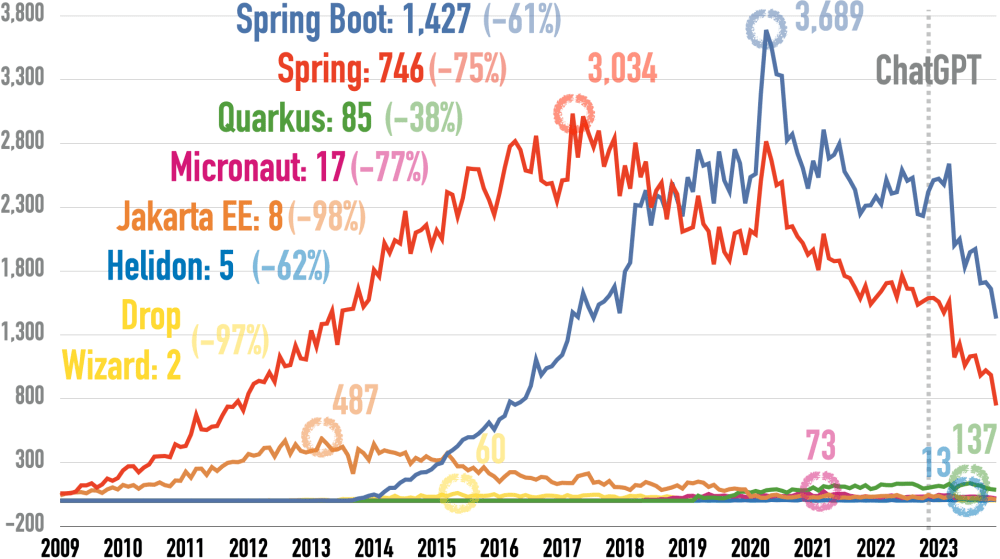
Spring Boot wins by an order of magnitude, while Quarkus places second and Jakarta EE third. Spring Boot lost 61% of its question volume in the last three years. Spring peaked three years earlier and is down 75%. Quarkus peaked in mid-2023 but lost 38% already. Micronaut’s 17 questions (per month!) are enough for the number three spot. Jakarta EE is down to a mere eight questions, just 2% of its all-time high of 486 questions in 2013. Helidon and DropWizard only have five and two questions – per month.
I used three queries to get the number of monthly questions below because putting all in one query timed out. You can run them in the StackExchange Data Explorer.
(Click to expand) Query 1: Spring, Spring Boot, Jakarta EE
DECLARE @StartDate DATE = '2009-01-01';
DECLARE @EndDate DATE = '2023-12-31';
WITH TaggedQuestions AS (
SELECT
Id,
CreationDate,
CASE WHEN CHARINDEX('<spring>', Tags) > 0 THEN 1 ELSE 0 END AS SpringTag,
CASE WHEN CHARINDEX('<spring-boot>', Tags) > 0 THEN 1 ELSE 0 END AS SpringBootTag,
CASE WHEN CHARINDEX('<jakarta-ee>', Tags) > 0 THEN 1 ELSE 0 END AS JakartaEETag
FROM PostsWithDeleted
WHERE
PostTypeId = 1 AND
CreationDate >= @StartDate AND
CreationDate <= @EndDate
),
MonthlyCounts AS (
SELECT
DATEADD(month, DATEDIFF(month, 0, CreationDate), 0) AS Month,
SUM(SpringTag) AS Spring,
SUM(SpringBootTag) AS SpringBoot,
SUM(JakartaEETag) AS JakartaEE
FROM TaggedQuestions
GROUP BY DATEADD(month, DATEDIFF(month, 0, CreationDate), 0)
)
SELECT
Month,
Spring,
SpringBoot,
JakartaEE
FROM MonthlyCounts
ORDER BY Month;
(Click to expand) Query 2: Quarkus and Micronaut
DECLARE @StartDate DATE = '2009-01-01';
DECLARE @EndDate DATE = '2023-12-31';
WITH TaggedQuestions AS (
SELECT
Id,
CreationDate,
CASE WHEN CHARINDEX('<quarkus>', Tags) > 0 THEN 1 ELSE 0 END AS QuarkusTag,
CASE WHEN CHARINDEX('<micronaut>', Tags) > 0 THEN 1 ELSE 0 END AS MicronautTag
FROM PostsWithDeleted
WHERE
PostTypeId = 1 AND
CreationDate >= @StartDate AND
CreationDate <= @EndDate
),
MonthlyCounts AS (
SELECT
DATEADD(month, DATEDIFF(month, 0, CreationDate), 0) AS Month,
SUM(QuarkusTag) AS Quarkus,
SUM(MicronautTag) AS Micronaut
FROM TaggedQuestions
GROUP BY DATEADD(month, DATEDIFF(month, 0, CreationDate), 0)
)
SELECT
Month,
Quarkus,
Micronaut
FROM MonthlyCounts
ORDER BY Month;
(Click to expand) Query 3: Helidon and DropWizard
DECLARE @StartDate DATE = '2009-01-01';
DECLARE @EndDate DATE = '2023-12-31';
WITH TaggedQuestions AS (
SELECT
Id,
CreationDate,
CASE WHEN CHARINDEX('<helidon>', Tags) > 0 THEN 1 ELSE 0 END AS HelidonTag,
CASE WHEN CHARINDEX('<dropwizard>', Tags) > 0 THEN 1 ELSE 0 END AS DropWizardTag
FROM PostsWithDeleted
WHERE
PostTypeId = 1 AND
CreationDate >= @StartDate AND
CreationDate <= @EndDate
),
MonthlyCounts AS (
SELECT
DATEADD(month, DATEDIFF(month, 0, CreationDate), 0) AS Month,
SUM(HelidonTag) AS Helidon,
SUM(DropWizardTag) AS DropWizard
FROM TaggedQuestions
GROUP BY DATEADD(month, DATEDIFF(month, 0, CreationDate), 0)
)
SELECT
Month,
Helidon,
DropWizard
FROM MonthlyCounts
ORDER BY Month;
Please note that the overall monthly number of Stack Overflow questions is down 55% since ChatGPT appeared (November 2022 vs. March 2024):

You can run the query below at the StackExchange Data Explorer.
(Click to expand) Query 4: All Questions
DECLARE @StartDate DATE = '2009-01-01';
DECLARE @EndDate DATE = '2024-03-31';
WITH Questions AS (
SELECT
Id,
CreationDate,
1 AS AQuestion
FROM PostsWithDeleted
WHERE
PostTypeId = 1 AND
CreationDate >= @StartDate AND
CreationDate <= @EndDate
),
MonthlyCounts AS (
SELECT
DATEADD(month, DATEDIFF(month, 0, CreationDate), 0) AS Month,
SUM(AQuestion) AS Questions
FROM Questions
GROUP BY DATEADD(month, DATEDIFF(month, 0, CreationDate), 0)
)
SELECT
Month,
Questions
FROM MonthlyCounts
ORDER BY Month;
Analysis
- Spring Boot dominates the Java ecosystem. It has the broadest support of libraries and third-party software working out of the box, conveniently configured consistently with Spring Boot. Spring Boot 3 has built-in support to create native Java executables with the GraalVM Native Image AOT compiler. You know, just like Quarkus, Micronaut, and Helidon have done for years. But with a multi-year head-start, these Spring Boot competitors probably produce smaller and faster native Java executables. If that matters to you, then go Quarkus or Micronaut.
- Jakarta EE is a vendor-independent specification with multiple implementations. It has had a rough couple of years: First, Oracle neglected it when it was still called “Java EE”. Oracle grudgingly transferred it to the Eclipse Foundation but required renaming all packages from
javax.*tojakarta.*. After Java EE 8 in August 2017, we had to wait five years for new features in Jakarta EE 10. But the more significant issue is that Jakarta EE was designed for application servers like IBM WebSphere that host many applications on big and expensive servers. We’re rapidly moving into a world where our Java applications run as close to the metal as possible, as microservices in small containers or even serverless. Will that world still have a place for Jakarta EE? Only time will tell. - MicroProfile is “Spring Boot with more Jakarta EE parts”, but without its broad support of libraries and third-party software. It started out of frustration with the slow progress of Java EE in 2016. Just like Jakarta EE, it is a vendor-independent specification with multiple implementations. It competes with Helidon to be the least popular framework, based on my measurements.
- Dropwizard is a framework that I had never heard of until the “JRebel 2021 Java Technology Report” declared it the #2 Java framework. Its origins seem to go back to 2012. It has the most job ad mentions besides Spring Boot and Jakarta EE.
- Quarkus is Red Hat’s take on a cloud-native Java framework. “Cloud-native” means producing small and fast applications: Quarkus claims 12 MB RAM for a REST application that starts in 0.016 seconds. It has the most mind-share as the cloud-native Spring Boot competitor. It’s the most popular framework besides Spring Boot and Jakarta EE.
- Micronaut is the second cloud-native Spring Boot competitor. It’s backed by consulting company Object Computing, which sponsors Grails and is less popular than Quarkus.
- Helidon is the third and least popular cloud-native Spring Boot competitor. It’s an Oracle framework and is currently the most unpopular one.
So here’s my recommendation:
- On your current project, keep your existing back-end framework unless that framework is absolutely, really not working out for you.
- If you need to switch back-end frameworks or are on a new project:
- Use Quarkus if you need the smallest possible, fastest-starting Java application now.
- Otherwise, use Spring Boot 3.
Next Issue
The next issue will arrive in June 2024. Subscribe to it as a newsletter to have it in your inbox then!